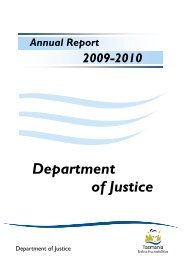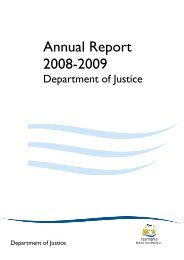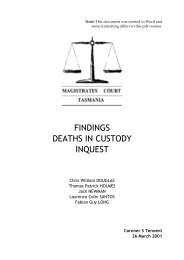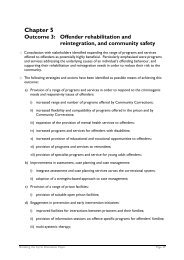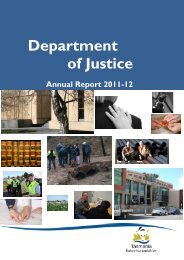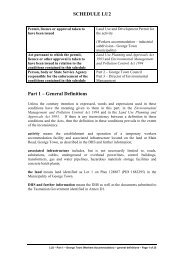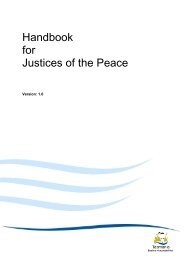Catholic Womens League - Tasmanian Department of Justice
Catholic Womens League - Tasmanian Department of Justice
Catholic Womens League - Tasmanian Department of Justice
Create successful ePaper yourself
Turn your PDF publications into a flip-book with our unique Google optimized e-Paper software.
Project Manager Sex Industry Review<br />
<strong>Department</strong> <strong>of</strong> <strong>Justice</strong><br />
GPO Box 825<br />
HOBART TAS 7001<br />
<strong>Catholic</strong> Women’s <strong>League</strong> Australia Inc.<br />
Submission from<br />
CATHOLIC WOMEN'S LEAGUE AUSTRALIA INC. (CWLA Inc.)<br />
Regarding<br />
Regulation <strong>of</strong> the Sex Industry in Tasmania, Discussion Paper 2012.<br />
<strong>Catholic</strong> Women’s <strong>League</strong> Australia Inc. (CWLA) is the national peak body representing the<br />
<strong>League</strong>'s seven member organisations located throughout Australia, and including Tasmania.<br />
We are a Non-Government Organisation (NGO) and have consultative (Roster) status with the<br />
Economic and Social Council <strong>of</strong> the United Nations. We are also a member organisation <strong>of</strong> the<br />
World Union <strong>of</strong> <strong>Catholic</strong> Women’s Organisations (WUCWO) which enables us to work with 5<br />
million women in more than 60 countries to promote the presence, participation and coresponsibility<br />
<strong>of</strong> <strong>Catholic</strong> women in society and the Church.<br />
Addressing social justice and ethical questions is one <strong>of</strong> our primary tasks. We seek to influence<br />
legislative and administrative bodies at all levels in order to preserve the dignity and rights <strong>of</strong> the<br />
human person, with particular focus on women and children. The subject matter <strong>of</strong> the current<br />
consultation is, therefore, <strong>of</strong> particular importance to our members and we are grateful for the<br />
opportunity to respond to the Regulation <strong>of</strong> the Sex Industry in Tasmania, Discussion Paper 2012.<br />
I. Prostitution is inherently harmful.<br />
Central to modern society’s recognition <strong>of</strong> human dignity and human rights is the Kantian<br />
notion that a person should be treated as an ‘end’ and never merely as a ‘means to an end.’<br />
Prostitution, however, treats women (and less frequently, men and children) physically,<br />
psychologically, and emotionally as a means to the sexual gratification <strong>of</strong> men. It treats women<br />
as ‘objects’ for sexual use rather than as ‘persons’ deserving <strong>of</strong> the opportunity to experience<br />
their identity, self-worth and agency through their sexuality. Because the vast majority <strong>of</strong><br />
prostituted persons are women, prostitution also represents a serious obstacle to gender<br />
equality.<br />
This objectification and exploitation is an <strong>of</strong>fence against the dignity (inherent value) <strong>of</strong> women,<br />
with serious negative secondary effects. The United Nations Convention for the Suppression <strong>of</strong> the<br />
Traffic in Persons and <strong>of</strong> the Exploitation <strong>of</strong> the Prostitution <strong>of</strong> Others (1949) states:<br />
…prostitution and the accompanying evil <strong>of</strong> the traffic in persons for the purpose <strong>of</strong><br />
prostitution are incompatible with the dignity and worth <strong>of</strong> the human person and<br />
endanger the welfare <strong>of</strong> the individual, the family and the community…(Preamble).<br />
1
<strong>Catholic</strong> Women’s <strong>League</strong> Australia Inc.<br />
<strong>Catholic</strong> social teaching expresses this in the following way: “Prostitution does injury to the<br />
dignity <strong>of</strong> the person who engages in it, reducing the person to an instrument <strong>of</strong> sexual<br />
pleasure.” (Catechism <strong>of</strong> the <strong>Catholic</strong> Church n. 2355)<br />
Prostitution is, therefore, inherently harmful and any attempt to re-frame prostitution as an<br />
ethically legitimate exchange <strong>of</strong> services and work is fundamentally misguided. The reality is that<br />
what is ‘exchanged’ - the use <strong>of</strong> a woman’s body and sexuality – is too personal to ever be sold<br />
and bought. Prostitution is like no other form <strong>of</strong> work since it involves the use <strong>of</strong> a woman’s<br />
body by the buyer for his sexual gratification. (Sullivan, 2005)<br />
This ‘market mentality’ is also falsely premised on the free participation <strong>of</strong> women in<br />
prostitution. The reality could not be further from the truth. As one prominent international<br />
researcher in this area explains:<br />
When prostituted women are asked, consistently around 90% say they want out <strong>of</strong><br />
prostitution immediately, but the decision is out <strong>of</strong> their hands and in the hands <strong>of</strong> their<br />
pimps, their husbands, their landlords, their addictions, their children's bellies. A study <strong>of</strong><br />
women in street prostitution in Toronto found that about 90% wanted to escape but<br />
could not and a 5-country study found that 92% <strong>of</strong> women, men and transgendered<br />
people in prostitution wanted immediate help to escape prostitution. If they are there<br />
because they cannot leave, then prostitution is not a freely made choice. (Farley, 2009)<br />
Project Respect, a service conducting outreach and <strong>of</strong>fering support to women in the sex<br />
industry across Victoria reports that <strong>of</strong> the 995 women they encountered in 2010/2011:<br />
<br />
<br />
<br />
<br />
<br />
<br />
75% are single mothers<br />
73% speak <strong>of</strong> either childhood or adulthood sexual abuse<br />
60% are currently or previously in a violent relationship<br />
47% financially support a partner<br />
33% are homeless<br />
35% either disclose excessive gambling or state that it was debt through<br />
gambling that forced them into the sex industry. (Women Matter: Project Respect<br />
Annual Report, 2010/2011)<br />
A large study published in 2003 surveying a population <strong>of</strong> 854 prostituted persons in nine<br />
countries across five continents, in virtually all forms <strong>of</strong> prostitution found that 59% <strong>of</strong> all<br />
respondents affirmed that they, as children, were “hit or beaten by caregiver until injured or<br />
bruised”. An additional 63% reported they were sexually abused as a child. In the same sample,<br />
75% reported they had been homeless, either currently or in the past. 47% reported they<br />
entered under age 18. (Farley, 2003)<br />
2<br />
2. Legalisation compounds the inherently harmful effects <strong>of</strong> prostitution.<br />
a. Legalisation creates a ‘culture <strong>of</strong> exploitation’<br />
Legalised (decriminalised or licensed) prostitution normalises and perpetuates the culture <strong>of</strong><br />
exploitation that is inherent in prostitution.<br />
Once prostitution is legalised, men who previously would not have risked buying women<br />
for sex now see prostitution as acceptable. When legal barriers disappear, so do the
<strong>Catholic</strong> Women’s <strong>League</strong> Australia Inc.<br />
social and ethical barriers to treating women as sexual merchandise. Legalisation <strong>of</strong><br />
prostitution sends the message to new generations <strong>of</strong> men and boys that women are<br />
sexual commodities and that prostitution is harmless fun. (Farley, 2009)<br />
Even when it is motivated by ‘harm minimisation’, the legalisation <strong>of</strong> prostitution is ultimately a<br />
concession to the ongoing exploitation <strong>of</strong> a group <strong>of</strong> women. Understood as a practice <strong>of</strong><br />
sexual exploitation, prostitution cannot be made safe. Those in it cannot realistically be<br />
protected. (MacKinnon, 2011) The only approach which is truly worthy <strong>of</strong> women is a mindset<br />
<strong>of</strong> ‘harm elimination’.<br />
While the welfare <strong>of</strong> prostituted women (men and children) should be the first priority,<br />
consideration must also be given to the effects <strong>of</strong> legalisation on the wider community. Do the<br />
majority <strong>of</strong> <strong>Tasmanian</strong>s want a flourishing and state sanctioned sex industry? Do they want<br />
prostitution to become a source <strong>of</strong> state revenue or to be integrated into the state tourism<br />
industry? Do they want a ‘red light’ district, or neighbourhood brothels? Do they believe that<br />
prostitution is an appropriate state sanctioned employment option for women in poverty?<br />
Following the legalisation <strong>of</strong> prostitution in Victoria, Sullivan and Jeffreys observed “an explosion<br />
<strong>of</strong> forms <strong>of</strong> sexual exploitation in the industry. Tabletop dancing, bondage and discipline centres,<br />
peep shows, phone sex and pornography -- all are developing pr<strong>of</strong>itably as part <strong>of</strong> a multi-million<br />
dollar industry <strong>of</strong> sexual exploitation.” (Sullivan and Jeffreys, 2001, p.3.)<br />
Tasmania must avoid the creation <strong>of</strong> a ‘prostitution culture’ where it is acceptable for men to<br />
purchase women for sexual gratification. (Sullivan, 2005)<br />
b. Legalisation expands both the legal and illegal sex industry.<br />
Experience in other jurisdictions demonstrates that legalisation <strong>of</strong> prostitution greatly expands<br />
the illegal, as well as legal sectors <strong>of</strong> the industry, effectively created a two tiered system.<br />
Following legalisation <strong>of</strong> prostitution in Victoria, although the number <strong>of</strong> legal brothels doubled,<br />
the greatest expansion was in illegal prostitution. In 1 year (1999), there was a 300% growth <strong>of</strong><br />
illegal brothels (Sullivan & Jeffreys). Illegal brothel prostitution burgeoned to meet buyers’<br />
demands for ‘cheaper’ or ‘unrestricted’ sexual services, including sex without condoms.<br />
(Sullivan, 2005) Additionally, many prostituted women are reluctant to work in legal operations<br />
to avoid disclosure.<br />
Most women in prostitution do not want to think that this is all their lives are ever going<br />
to be. To become legal requires disclosure <strong>of</strong> a real name, registration, going to a<br />
hospital to get cleaned up, which in turn relies on and creates records. This in turn<br />
means deciding that prostitution will be part <strong>of</strong> your <strong>of</strong>ficial life story. Most prostituted<br />
women, even if they have to do this now, have dreams. (MacKinnon, 2011)<br />
Another factor encouraging the growth <strong>of</strong> the illegal sector is that once “the illegal market<br />
explodes, the governmental apparatus to address it erodes because the industry is<br />
decriminalized, no one sees any harm in it, and the illegal market intersects and overlaps the<br />
legal market.” (MacKinnon, 2011)<br />
The 2004 review <strong>of</strong> the Queensland Act found that only about 10 per cent <strong>of</strong> all prostitution<br />
services available in Queensland were operating within the legal brothel system.<br />
3
<strong>Catholic</strong> Women’s <strong>League</strong> Australia Inc.<br />
c. Legalisation does not provide prostituted women with substantive benefits.<br />
Putting aside the philosophical problems with harm minimisation, there are also practical<br />
reasons against the legalisation <strong>of</strong> prostitution. Sullivan explains that prostitution is inherently<br />
violent and incapable <strong>of</strong> being regulated.<br />
Even given the supposedly optimum circumstances in which prostitution can take<br />
place—that is, in Victoria’s legal brothels and escort agencies—women continue to be<br />
raped and traumatised. Attempts to treat prostitution businesses as similar to other<br />
mainstream workplaces actually obscure the intrinsic violence <strong>of</strong> prostitution. This<br />
violence is entrenched in everyday ‘work’ practices and the ‘work’ environment and<br />
results in ongoing physical and mental harm for women who must accept that in a legal<br />
system such violence has been normalised as just part <strong>of</strong> the job. (Sullivan, 2005. p.5)<br />
A study <strong>of</strong> the Netherlands, where prostitution is legal, found 60% <strong>of</strong> prostituted women<br />
suffered physical assaults; 70% experienced verbal threats <strong>of</strong> physical assault; and 40%<br />
experienced sexual violence. (Vanwesenbeeck, 1994, cited in Farley 2004, p. 1095)<br />
A nine-country study found that 68% <strong>of</strong> the prostituted persons met criteria for posttraumatic<br />
stress disorder with symptoms in the same range as for battered women seeking shelter,<br />
survivors <strong>of</strong> rape, and refugees from state-organised torture. Such symptoms were found<br />
regardless <strong>of</strong> whether prostitution was legalised or criminalised, and regardless <strong>of</strong> whether it<br />
took place indoors, in brothels, on the streets, or in developing as opposed to fully<br />
industrialized countries. (Farley et al., 2003, 44–49, 56).<br />
A 2008 New Zealand government committee inquiring into their prostitution laws found that<br />
violence against women in prostitution had continued after prostitution was decriminalised. The<br />
majority” <strong>of</strong> prostituted persons as well as brothel operators felt that the Prostitution Reform<br />
Act <strong>of</strong> 2003 could do little about such violence (Prostitution Law Review Committee, 2008, 14,<br />
57).<br />
The German government has concluded that legalising the German sex industry has failed to<br />
deliver any <strong>of</strong> the promised tangible benefits to prostituted people:<br />
The Prostitution Act has . . . up until now . . . not been able to make actual, measurable<br />
improvements to prostitutes’ social protection. As regards improving [their] working<br />
conditions, hardly any measurable, positive impact has been observed in practice . . . .<br />
The Prostitution Act has not recognisably improved the prostitutes’ means for leaving<br />
prostitution. There are as yet no viable indications that [it] has reduced crime [or]<br />
contributed . . . transparency in the world <strong>of</strong> prostitution . . . ( Report by the German<br />
Federal Government on The Impact <strong>of</strong> the Act Regulating the Legal Situation <strong>of</strong><br />
Prostitutes, 2007)<br />
d. Legalisation promotes trafficking<br />
MacKinnon notes that experience in the Netherlands, Germany, Victoria and elsewhere shows<br />
that when prostitution is legalised, trafficking goes through the ro<strong>of</strong>. “As a business decision, it<br />
makes sense to traffic women and children where business is legal because once you get them<br />
there, the risks to sellers are minimal even if trafficking is formally a crime, and the pr<strong>of</strong>its to be<br />
made from operating in the open are astronomical.” (MacKinnon, 2011, p. 304.)<br />
4
<strong>Catholic</strong> Women’s <strong>League</strong> Australia Inc.<br />
Victoria is a well-documented instance where legalisation has been identified as a “pull factor”<br />
for traffickers. (Bindel, 2003) Brothels create a demand for constant new recruits and fuel the<br />
illegal trafficking industry. (Sullivan and Jeffreys, 2000.) Where prostitution is legal, sex<br />
industries are larger and create a demand for more women to sell sex, attracting traffickers and<br />
others who exploit women for financial gain. (Farley, 2009)<br />
3. The criminalisation <strong>of</strong> the purchase <strong>of</strong> sexual services and<br />
decriminalisation <strong>of</strong> prostituted persons provides the best outcome for<br />
prostituted persons.<br />
The evidence is clear that legalisation and decriminalisation fail to protect women in prostitution<br />
and the wider community. Fortunately there is another positive legislative option, founded<br />
upon the recognition <strong>of</strong> prostitution as overwhelmingly unequal, exploitative, and harmful to<br />
prostituted persons. In Sweden, the criminalisation <strong>of</strong> the purchase <strong>of</strong> sexual services and<br />
decriminalisation <strong>of</strong> the prostituted person has significantly reduced the occurrence <strong>of</strong><br />
prostitution in Sweden compared to neighbouring countries. (Waltman, 2011)<br />
Regrettably, the efficacy <strong>of</strong> the Swedish legislative approach is poorly represented by the<br />
Regulation <strong>of</strong> the Sex Industry in Tasmania, Discussion Paper 2012. Therefore, the following points<br />
highlight the objective shortcomings <strong>of</strong> the Discussion Paper in this regard, as well as the major<br />
positive conclusions <strong>of</strong> the 2010 Swedish government report, The Ban Against the Purchase <strong>of</strong><br />
Sexual Services. An evaluation 1999-2008.<br />
i. The Discussion Paper records the Swedish report as stating “The number <strong>of</strong> foreign<br />
women in street prostitution has increased in Sweden” but does not include the citation:<br />
The number <strong>of</strong> foreign women in street prostitution has increased in all the Nordic countries,<br />
including Sweden. However, by comparison it can be noted that the dramatic increase in<br />
the number <strong>of</strong> foreign women in street prostitution reported from both Denmark<br />
and Norway has no parallel in Sweden. (Report p.35)<br />
ii.<br />
The discussion paper cites the report as stating “(M)ost young people who are exploited<br />
sexually in return for payment came into contact with the purchaser via the Internet…<br />
The ban on the purchase <strong>of</strong> sexual services has not had an effect on the exposure <strong>of</strong><br />
young people on the internet.” It does not, however, mention the broader finding <strong>of</strong><br />
the report regarding internet prostitution:<br />
In the last five years, Internet prostitution has increased in Sweden, Denmark and Norway.<br />
However, the scale <strong>of</strong> this form <strong>of</strong> prostitution is more extensive in our neighbouring countries,<br />
and there is nothing to indicate that a greater increase in prostitution over the<br />
Internet has occurred in Sweden than in these comparable countries. This<br />
indicates that the ban has not led to street prostitution in Sweden shifting arenas<br />
to the Internet. (Report p.35)<br />
iii.<br />
Regarding the question <strong>of</strong> whether there has been an overall reduction in the number <strong>of</strong><br />
sex workers in Sweden since the introduction <strong>of</strong> the Swedish laws, the Discussion Paper<br />
cites a Report published in 2007 by the National Board <strong>of</strong> Health and Welfare in<br />
Sweden:<br />
5
<strong>Catholic</strong> Women’s <strong>League</strong> Australia Inc.<br />
It is also difficult to discern any clear trend <strong>of</strong> development: has the extent <strong>of</strong> prostitution<br />
increased or decreased? We cannot give any unambiguous answer to that question. At most, we<br />
can discern that street prostitution is slowly returning, after swiftly disappearing in the wake <strong>of</strong><br />
the law against purchasing sexual services. But as said, that refers to street prostitution, which is<br />
the most obvious manifestation. With regard to increases and decreases in other areas <strong>of</strong><br />
prostitution – the ―hidden prostitution – we are even less able to make any statements.<br />
However, the Discussion Paper overlooks the more recent conclusion <strong>of</strong> the 2010<br />
Swedish Government report:<br />
The overall picture we have obtained is that, while there has been an increase in<br />
prostitution in our neighbouring Nordic countries in the last decade, as far as we<br />
can see, prostitution has at least not increased in Sweden. There may be several<br />
explanations for this but, given the major similarities in all other respects between the Nordic<br />
countries, it is reasonable to assume that prostitution would also have increased in Sweden if we<br />
had not had a ban on the purchase <strong>of</strong> sexual services. Criminalisation has therefore helped to<br />
combat prostitution. (Report p.36)<br />
iv.<br />
The Discussion Paper includes a list <strong>of</strong> ‘shortcomings with the law’ identified by critics <strong>of</strong><br />
the Swedish criminalisation approach. It is worth noting, however, that there are only two<br />
sources for this list – Ostergren’s “Sex workers’ Critique <strong>of</strong> Swedish Prostitution Policy<br />
2004” and the Queensland Prostitution Licensing Authority – and no presentation <strong>of</strong> the<br />
relevant opposing view <strong>of</strong> the Swedish Government Report:<br />
When the ban on the purchase <strong>of</strong> sexual services was introduced, various misgivings were<br />
voiced. These included fears that criminalisation would risk driving prostitution underground,<br />
making it harder to reach out to the vulnerable people involved through social measures, and<br />
that the ban would bring an increased risk <strong>of</strong> physical abuse and generally worsen living<br />
conditions for prostitutes. As far as we can judge from the written material and the<br />
contacts we have had with public <strong>of</strong>ficials and people involved in prostitution,<br />
these fears have not been realised. (Report p.37-8)<br />
v. The Discussion Paper omits significant findings <strong>of</strong> the Swedish Government report<br />
concerning human trafficking, public opinion and the numbers <strong>of</strong> men who purchase<br />
sexual services.<br />
<br />
<br />
Although it is hard to assess the exact scale <strong>of</strong> human trafficking for sexual purposes, in Sweden<br />
the establishment <strong>of</strong> this kind <strong>of</strong> crime is considered to be substantially smaller in scale than in<br />
other comparable countries. According to the National Criminal Police, it is clear that the ban<br />
on the purchase <strong>of</strong> sexual services acts as a barrier to human traffickers and<br />
procurers considering establishing themselves in Sweden. (Report p.37)<br />
Judging by the results <strong>of</strong> four population-based opinion polls, there has been a change <strong>of</strong><br />
attitude with regard to the purchase <strong>of</strong> sexual services that coincides with the criminalisation <strong>of</strong><br />
the purchase <strong>of</strong> such services. The marked shift in attitude that has occurred here – without an<br />
equivalent shift in Norway and Denmark – must be interpreted as meaning that the ban itself<br />
has had a significant normative effect which, given that support for<br />
criminalisation is greatest among young people, can be expected to last. In all three<br />
surveys conducted since the ban was introduced, more than 70 per cent <strong>of</strong> those asked took a<br />
positive view <strong>of</strong> the ban. (Report p.37)<br />
6
<strong>Catholic</strong> Women’s <strong>League</strong> Australia Inc.<br />
<br />
According to surveys conducted in Sweden in the period following criminalisation, the<br />
proportion <strong>of</strong> men reporting that they have, on some occasion, purchased sexual<br />
services has decreased, and it would seem that fewer men purchase sexual services in<br />
Sweden than in the other Nordic countries. (Report p.38)<br />
In conclusion, an accurate reading <strong>of</strong> the 2010 Swedish Government report demonstrates that<br />
their model is working to reduce the demand for sexual services and protect women from<br />
exploitation. For good reasons, this approach has now been adopted in Norway, Iceland and<br />
Korea, and is under serious consideration in France, Israel and parts <strong>of</strong> the United States <strong>of</strong><br />
America.<br />
4. Recommendations<br />
Internationally, there is a growing consensus that prostitution is inherently harmful to<br />
prostituted persons and that decriminalisation or licensing further compounds this harm. The<br />
criminalisation <strong>of</strong> the purchase <strong>of</strong> sexual services and decriminalisation <strong>of</strong> prostituted persons<br />
provides the best outcome for prostituted persons.<br />
Tasmania now has the opportunity to move beyond harm minimisation strategies which have<br />
been tried and found wanting.<br />
CWLA Inc. recommends the following progressive measures to protect women (men and<br />
children) from the inherent harm <strong>of</strong> prostitution by reducing demand for sexual services.<br />
a. Tasmania‘s legislation in respect <strong>of</strong> sexual services provided for fee or reward to and by<br />
consenting adults should criminalise the purchase <strong>of</strong> sexual services (the ‘Swedish<br />
criminalisation approach’)<br />
b. The government should introduce strategies to assist people in prostitution to leave the<br />
industry and find alternative means <strong>of</strong> support, through such measures as counseling,<br />
education and job training.<br />
c. Education and information should be provided to heighten people’s awareness <strong>of</strong> the<br />
inherent harm <strong>of</strong> prostitution and help them rethink their attitudes to those exposed to<br />
prostitution and trafficking for sexual purposes.<br />
d. At the very least, the government should resist going down a path <strong>of</strong> decriminalisation or<br />
licensing, and maintain current legislation which:<br />
<br />
<br />
<br />
<br />
provides that it is illegal for a person to employ or otherwise control or pr<strong>of</strong>it from<br />
the work <strong>of</strong> individual sex workers.<br />
prohibits more than two sex workers to work together in a partnership<br />
arrangement.<br />
makes it an <strong>of</strong>fence to <strong>of</strong>fer or procure sexual services in a public place – making<br />
street prostitution illegal for both worker and client.<br />
establishes a range <strong>of</strong> <strong>of</strong>fences relating to coercion <strong>of</strong> sex workers.<br />
7
<strong>Catholic</strong> Women’s <strong>League</strong> Australia Inc.<br />
Authorised by:<br />
Jean R Tanzer O.A.M<br />
National President, CWLA<br />
Marcia Riordan BSc M Bioethics<br />
National Social Issues Convenor, CWLA<br />
Prepared by:<br />
(Dr) Brigid McKenna MBBS (Tas) M Bioethics<br />
Research Officer<br />
CWLA Research Centre<br />
108 Bathurst St<br />
Hobart TAS 7000<br />
0488 130 630 | research<strong>of</strong>ficer@cwla.org.au<br />
References:<br />
Bindel, Julie and Kelly, Liz. A Critical Examination <strong>of</strong> Responses to Prostitution in Four Countries:<br />
Victoria, Australia; Ireland; the Netherlands; and Sweden. Child and Woman Abuse Studies Unit,<br />
London Metropolitan University, 2003.<br />
Farley, Melissa. Myths and Facts about Trafficking for Legal and Illegal Prostitution, March 2009.<br />
http://www.prostitutionresearch.com/c-laws-about-prostitution.html<br />
Farley, Melissa. “Bad for the Body, Bad for the Heart”: Prostitution Harms Women Even if<br />
Legalized or Decriminalized.” Violence Against Women, Oct 2004, Vol. 10 No. 10.<br />
Farley, Melissa, et al. Prostitution and Trafficking in Nine Countries: An Update on Violence and<br />
Posttraumatic Stress Disorder, 2003.<br />
http://www.prostitutionresearch.com/pdf/Prostitutionin9Countries.pdf<br />
MacKinnon, Catharine A. “Trafficking, Prostitution, and Inequality,” Harvard Civil Rights-Civil<br />
Liberties Law Review, 2011, Vol. 46, pp.271-309.<br />
Report By The German Federal Government On The Impact Of The Act Regulating The Legal<br />
Situation Of Prostitutes (2007), available at Publikationsverstand der Bundesregierung,<br />
www.bmfsfj.de<br />
Selected extracts <strong>of</strong> the Swedish government report SOU 2010:49: The Ban against the Purchase<br />
<strong>of</strong> Sexual Services. An evaluation 1999-2008, Swedish Institute, November 2010.<br />
Sullivan, Mary and Jeffreys, Sheila. Legalising Prostitution Is Not The Answer: The Example Of Victoria,<br />
Australia, 2001. http://catwa.org.au/?q=node/13<br />
Sullivan, Mary. What Happens When Prostitution Becomes Work? An Update on Legalisation <strong>of</strong><br />
Prostitution in Australia. N. Amherst, MA: Coalition Against Trafficking in Women (CATW), 2005.<br />
http://catwa.org.au/?q=node/13<br />
Waltman, Max. “Sweden's prohibition <strong>of</strong> purchase <strong>of</strong> sex: The law's reasons, impact, and<br />
potential,” Women's Studies International Forum, 2011, 34.<br />
8



